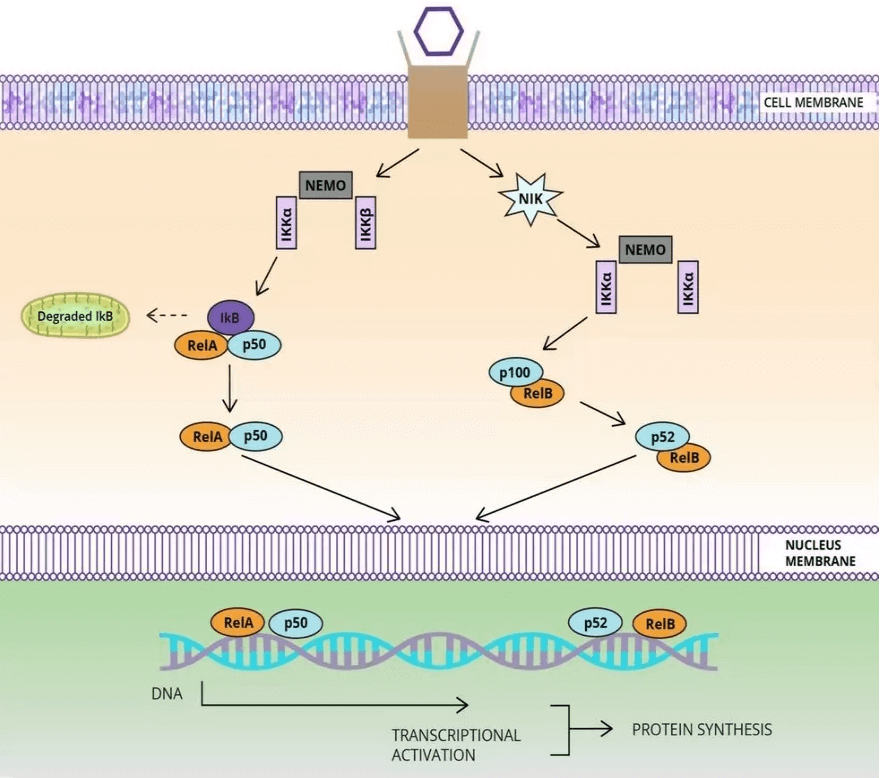NF-κB signaling pathway
Based on Luminex technology platform, Creative Proteomics provides analysis services for key targets of NF-κB signaling pathway.
NF-κB transcription factors are critical regulators of immunity, stress responses, apoptosis and differentiation. In mammals, there are five members of the transcription factor NF-κB family: RELA (p65), RELB and c-REL, and the precursor proteins NF-κB1 (p105) and NF-κB2 (p100), which are processed into p50 and p52, respectively. NF-κB transcription factors bind as dimers to κB sites in promoters and enhancers of a variety of genes and induce or repress transcription.
NF-κB activation occurs via two major signaling pathways: the canonical and the non-canonical NF-κB signaling pathways.
- The canonical NF-κB pathway
The canonical NF-κB pathway is triggered by signals from a large variety of immune receptors, such as TNFR, TLR, and IL-1R, which activate TAK1. TAK1 then activates IκB kinase (IKK) complex, composed of catalytic (IKKα and IKKβ) and regulatory (NEMO) subunits, via phosphorylation of IKKβ. Upon stimulation, the IKK complex, largely through IKKβ, phosphorylates members of the inhibitor of κB (IκB) family, such as IκBα and the IκB-like molecule p105, which sequester NF-κB members in the cytoplasm. IκBα associates with dimers of p50 and members of the REL family (RELA or c-REL), whereas p105 associates with p50 or REL (RELA or c-REL). Upon phosphorylation by IKK, IκBα and p105 are degradated in the proteasome, resulting in the nuclear translocation of canonical NF-κB family members, which bind to specific DNA elements, in the form of various dimeric complexes, including RELA-p50, c-REL-p50, and p50-p50. Atypical, IKK-independent pathways of NF-κB induction also provide mechanisms to integrate parallel signaling pathways to increase NF-κB activity, such as hypoxia, UV and genotoxic stress.

- The non-canonical NF-κB pathway
The non-canonical NF-κB pathway is induced by certain TNF superfamily members, such as CD40L, BAFF and lymphotoxin-β (LT-β), which stimulates the recruitment of TRAF2, TRAF3, cIAP1/2 to the receptor complex. Activated cIAP mediates K48 ubiquitylation and proteasomal degradation of TRAF3, resulting in stabilization and accumulation of the NFκB-inducing kinase (NIK). NIK phosphorylates and activates IKKα, which in turn phosphorylates p100, triggering p100 processing, and leading to the generation of p52 and the nuclear translocation of p52 and RELB.
Our detectable targets:
| LYN | SYK | BLK | MYD88 | RIPK1 | TRADD |
| TRAF2 | TRAF5 | RNF135 | TRIM25 | TIRAP | TRAM |
| TRIF | TRAF6 | RIP1 | TRAF3 | clAP1 | clAP2 |
| NIK | TBK1 | MKK3 | NFκB | MKK4 | MKK6 |
| MKK7 | IPS1 | IRAK1 | IRAK4 | BLNK | BTK |
| DAG | PKC | ELKs | REL | CK2 | ATM |
| IKK-α | NEMO | PIDD | p50 | RIP1 | PARP1 |
| SUMO | RELA | lkBa | IRF7 | Tak1 | IRF3 |
| BCL-10 | p38 | p52 | RELB | TBK1 | PKC |
| IKK-β |
Technology platform
We provide Luminex technology for NF-κB signaling pathway analysis.
Luminex technology is a multifunctional liquid phase analysis platform developed on the basis of colored microspheres, laser technology, applied fluidics and high-speed digital signal processing technology. The core is to encode polypropylene microspheres or magnetic microspheres with fluorescent dyes. By adjusting the different ratios of the two fluorescent dyes, up to 100 microspheres with different fluorescence spectra can be obtained. Each kind of microspheres is covalently cross-linked. Capture antibodies against specific antigens.
The NF-kB signaling pathway is a family of mammalian transcription factors NF-kB, composed of P50, P52, REL, REL-A and REL-B, and is widely used in the processing of tumor necrosis and lymphotoxin receptor activator.
In addition to Luminex Multiplex Assay, Enzyme-linked immunosorbent assay (ELISA), Flow cytometry (FACS analysis) technology can also be provided to meet other customer needs.
Advantages of NF-κB signaling pathway detection:
- High flexibility: specific probes, antigens or antibodies can be connected to the microspheres to meet the needs of different customers.
- High sensitivity: the detection limit can reach 0.01pg/ml.
- Good repeatability: similar homogeneous reaction mode, each indicator has 1000-5000 reaction units, and the median value of 100 analysis is taken.

Application of our service:
- To study the effects of drugs or therapies on NF-κB signaling pathways
- To study the effect of each virus on NF-κB signaling pathway
- To study the regulation mechanism of NF-κB signaling pathway in disease
Creative Proteomics has developed a signal pathway target detection platform. We are not limited to providing NF-κB signaling path detection services, but can also provide other signal path detection services. If you want to detect other targets, please contact us and we will customize the service for you. Look forward to working with you.
References:
- Oeckinghaus A, et al. The NF-kappaB family of transcription factors and its regulation. Cold Spring Harb Perspect Biol, 2009, (4):a000034.
- Taniguchi K, et al. NF-κB, inflammation, immunity and cancer: coming of age. Nat Rev Immunol, 2018, 18(5): 309-324.
- Perkins ND, et al. Integrating cell-signalling pathways with NF-kappaB and IKK function. Nat Rev Mol Cell Biol, 2007, 8(1): 49-62.



